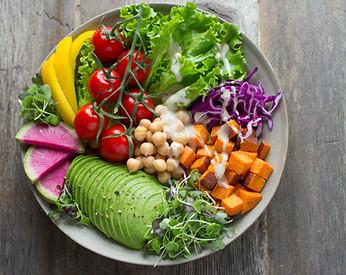Eating Well
The key to living well with diabetes is to manage blood sugar, and eating well is the key to managing blood sugar. Eat healthful foods in the proper amounts at the right times to keep your blood sugar as close to normal as feasible.
Create a healthy eating plan with your nutritionist or diabetes educator, then look through the resources in this section for tips, tactics, and ideas to make eating well easier.


Diabetic Meal Planning
A meal plan serves as a guidance for when, what, and how much to eat in order to acquire the nourishment you require while keeping your blood sugar levels within your target range. A smart meal plan will take into account your goals, preferences, and lifestyle, as well as any medications you are taking.

Grocery Shopping
-
Before you go grocery shopping, plan out a week's worth of meals.
-
Check what you already have so you don't buy something you don't need.
-
Create a grocery list based on your weekly meal plan. For quick and easy shopping, organize your list by store department.
-
Don't go shopping hungry so you're not tempted to buy foods that aren't on your shopping list.
-
Fresh fruits and vegetables, dairy or dairy alternatives, meat, fish, poultry, and eggs can all be found in the outer aisles.
-
Healthy options such as beans, lentils, flavored vinegars, spices, tuna fish, olive oil, and frozen fruit and vegetables can be found on the inside aisles (without sauce).
-
Read the Nutrition Facts label to find out what's in the food. Be aware of food claims such as "lower in fat" or "reduced sugar", it may still be a bad choice.
Healthy Snack Suggestions
To build a snack you can choose one carbohydrate food and one protein or healthy-fat food from each side.
Carbohydrates (Carbs)
Proteins and Healthy Fats
-
1 small apple
-
1 small sweet potato
-
1 small banana
-
1/2 cup of cooked plain oatmeal
-
1 small pear
-
1 1/4 cups of strawberries
-
3/4 cup of blueberries
-
3 graham cracker squares
-
5 small whole-wheat crackers
-
1 slice of bread with 3 or more grams of fiber
-
3/4 cup of unsweetened dry cereal
-
1 tbsp. of peanut butt, almonds, or cashews
-
1 or 2 ounces (oz.) of chicken salad
-
1 to 2 oz. of skinned chicken
-
1 to 2 oz. of low-sodium turkey
-
2 oz. of tuna
-
1 hard-boiled egg
-
4 oz. of low-fat cottage cheese
-
1 string cheese or 1 slice of Swiss cheese
-
10 unsalted almonds or peanut
-
1/4 avocado
-
2 tbsp. of hummus
-
8 oz. glass of low-fat milk
-
6 oz. of low-fat or fat-free yogurt
The snacks listed here may cause a small increase in blood sugar but are NOT to be used to treat low blood sugar problem.
NOTE: Always check with your doctor or diabetes educator before you make any change in your diabetes meal plan!




Diabetes Plate Method
The Diabetes Plate Method is the simplest way to make nutritious meals that can help you control your blood sugar. With this method, you can create correctly portioned meals with a healthy balance of veggies, protein, and carbohydrates without counting, calculating, weighing, or measuring.

